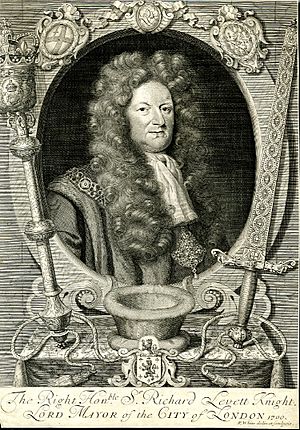Richard Levett facts for kids
Quick facts for kids
Sir Richard Levett
|
|
|---|---|
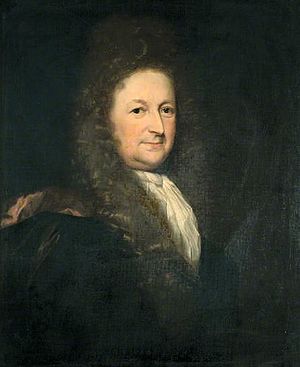
1699 portrait by Godfried Schalcken
|
|
| Born |
Ashwell, Rutland
|
| Died | 20 January 1711 Kew, England
|
| Resting place | St Anne's Church, Kew, Richmond-upon-Thames |
| Spouse(s) |
|
| Children | Elizabeth, Mary, Frances, Anne, Richard |
| Parent(s) | Richard Levett Katherine Levett |
Sir Richard Levett (died 1711) was an English businessman and politician. He became the Lord Mayor of London in 1699. Born in Ashwell, Rutland, he later moved to London. There, he built a successful business career. He worked with important organizations like the Bank of England and the East India Company. Sir Richard knew many famous people of his time, including Samuel Pepys and Robert Hooke. He owned several properties in Kew and Cripplegate before he passed away in 1711.
Contents
Sir Richard Levett's Early Life and Business
Sir Richard Levett came from an old family that had once been very powerful. However, his family had lost much of its wealth by the time he was born. His father was a minister who lost his job in 1660 when the old government returned. This meant Richard and his brother, Francis, had to rely on themselves. They became pioneers in the business world.
Even though they had an old family name, the Levett brothers were middle-class. They showed that with hard work, ordinary people could become very successful. Their rise was helped by big changes happening in England. Trade was growing, and new business opportunities were appearing. This allowed a new group of merchants to become important. Sir Richard Levett believed in free markets, where businesses could trade freely.
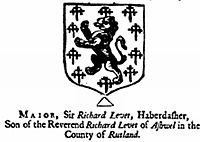
Richard and Francis Levett started as small haberdashers, selling many different goods like tobacco and fabrics. They imported goods into England and then sold them to traveling sellers called chapmen at fairs across the country. As the British Empire grew stronger, merchants like the Levetts expanded their businesses. Their small operation grew into a large company. They even used their own ships to bring in goods from all over the world.
Their company became one of the biggest trading businesses in England. They traded with places like Turkey, India, Africa, the West Indies, North America, Ireland, and even Russia. Records show that Levett was often involved in planning shipping and trading trips to many different places. Like many merchants in London at that time, Levett was involved in the Atlantic slave trade. This meant transporting enslaved people from parts of West Africa to be sold in English colonies like Virginia and Maryland.
Building a Business Empire
By the early 1700s, Sir Richard Levett and Company was one of England's largest businesses. They were especially important in the huge tobacco trade with the Virginia Colony and also with tobacco from Turkey.
Levett became a director of the Honourable East India Company, which was a powerful trading company. He was also one of the first directors of the new Bank of England. In 1698, he became a member of the New England Company. Because he was so involved in shipping, Levett was also an early investor in what became Lloyd's of London, a famous insurance company. He was made a knight in 1691.
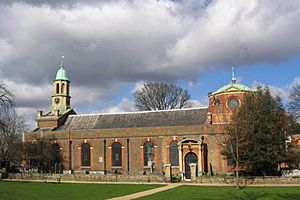
In the busy world of London traders, Levett often worked with or competed against other big merchants. For example, at a meeting of the East India Company in 1701, he met with other important traders and officials.
In 1695, Levett's company imported a huge amount of tobacco into England. They then sold a large part of it to countries like Holland, Germany, and the Baltic. By acting as middlemen in this growing business, Levett and his partners made a lot of money. This was partly because they had access to a lot of money and their own ships.
As his trading business grew, Richard Levett became a well-known person in London. He was chosen as the Master of the Haberdashers' Company (a guild for merchants) in 1690 and 1691. He also served as Sheriff of the City of London in 1691, an Alderman, and finally, in 1699, Lord Mayor of London. As Master of the Haberdashers' Company, Levett helped build Sir Robert Aske's Hospital, with his friend Robert Hooke as the architect.
From his home in Cripplegate, Levett managed his trading empire and his duties as Lord Mayor. His home was a large mansion on Noble Street.
Family Life and Homes
Sir Richard Levett also had two country homes in Kew. One of these was the Dutch House, which is now known as Kew Palace. After Sir Richard died, his daughter Mary Thoroton rented the Dutch House to Queen Caroline, who was the wife of King George II. The Queen used it as a nursery for her children. Both of Levett's homes and the land around them were later sold to the Royal family in 1781 by his grandson.
Sir Richard Levett was married to Mary Crispe. She was likely the daughter of another merchant, Sir Nicholas Crispe. The couple was well-known in London after the Restoration period. Sir Richard Levett was even mentioned in the diaries of Samuel Pepys, a famous diarist. Levett was often mentioned in stories about weddings and parties of the time. He also became a philanthropist, which means he donated money to charities. He gave to places like St. Thomas' Hospital and church charities.
Sir Richard Levett's wife, Mary, was also very generous to religious causes. A churchman named Edmund Calamy called "Lady Levett" his great "friend." She was known for giving money to religious and educational causes.
Samuel Pepys, who wrote famous diaries, seemed to spend time with Richard Levett. Pepys wrote in his diary on March 14, 1668, about trying to meet with Levett. He said that Levett eventually agreed to leave his business to meet him, which made Pepys feel much better. Levett also appears in the diaries of politician Roger Whitley.
Death and Legacy
Sir Richard Levett died in 1711. He, his wife, and several of their daughters are buried in the churchyard at St. Anne's Church, Kew. There are memorials to them inside the church. An inscription on a wall in the church reads: "Within this vault lie the remains of Sir Richard Levett, Knight, of Kew. Also of Lady Mary Levett, his wife, who died October 15th, 1722."
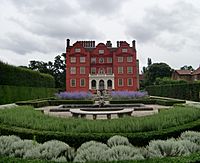
Sir Richard Levett's son, also named Richard, became an Alderman and Sheriff of London. He took over his father's businesses but did not manage them well. Because of this, many family treasures were passed to the Hulse family, who were related through Sir Richard's daughter.
Sir Richard had another brother, Rev. Dr. William Levett, who was a dean at a church. Their uncle, also named William Levett, was a courtier who traveled with King Charles I during difficult times.


